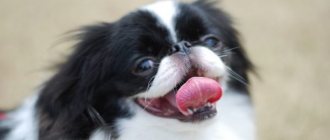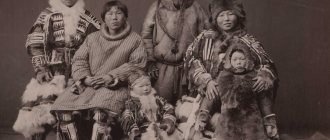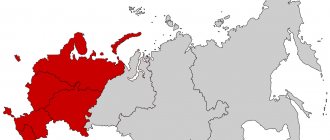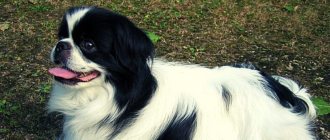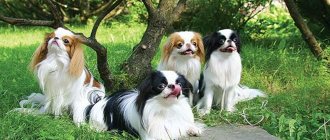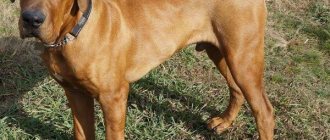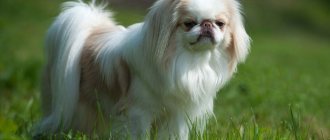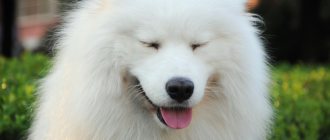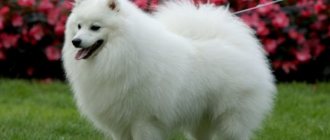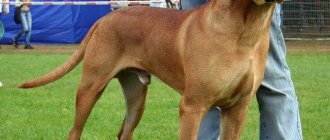Miniature decorative Japanese Chin looks very funny. He has such an appearance - the result of the work of ancient scientists, who fulfilled the requirements of the Japanese emperors: to create a wonderful mood for them with the help of a dog and create additional harmony on the territory of the palace. This wish was fulfilled so successfully that even after centuries, the Japanese Chin still pleases its owners with both its funny appearance and its exemplary behavior.
History and characteristics of the breed
Origin
The Japanese Chin is an ancient breed beloved by aristocrats
The history of the appearance of the breed is not reliably known. Dogs similar to chins were first mentioned 3,000 years ago. Proponents of one version of the origin of the breed claim that the ancestors were brought to Japan from India and China in the 3rd century. According to this assumption, Chins, Pekingese and Pugs descended from the Tibetan Toy. Another version is based on information obtained from the ancient epic. This text indicates that the Korean emperor in 732 presented the dogs that became the founders of the breed as a gift to the Japanese monarch. It is also believed that the ancestors of the Chin were brought by Japanese aristocrats from China.
Important! In the 17th–19th centuries, the breed was especially popular among the nobility and symbolized a high position in society. Representatives of the lower strata of the Japanese population were prohibited from owning these dogs under threat of death.
Active breeding of the breed began in the 16th century. The ancestors of the Chins were crossed with small Japanese dogs. In 1613, the breed appeared in England, where it was brought by Captain Sirlis. Such dogs were common among the aristocracy. In 1860, Chins were presented to the British Queen Victoria as a gift, which brought them official recognition in Europe. From that time on, the breed began to spread in Western countries. From the second half of the 19th century, chins were actively exported from Japan to Europe and the USA. This breed first took part in the exhibition in 1873, the standard was approved in 1961.
Description of standards with photos
Japanese Chin - a breed of small indoor dogs
The height of chins reaches 25 cm, and their weight is only 1.5–3.5 kg. The height at the withers should correspond to the length of the body. The dog has a round and wide skull with a convex forehead. The bridge of the nose is short, the color of the nose can be black or flesh-colored. The teeth are strong, the bite should preferably be straight, but the standard also includes a scissor bite. The eyes are black, almond-shaped, large, and widely spaced. The ears are triangular and drooping. The neck is short.
The back is straight. The loin is slightly rounded. The chest is small in width and deep. The stomach is noticeably tucked. The forelimbs are thin-boned, without bends. The hind legs show moderate angulation. The tail is located on the back. The coat is long and straight, has a silky texture. The color is white with red or black spots. It is desirable to have a wide groove from the top of the skull to the bridge of the nose. The lifespan of the Chin is 10–15 years.
The Chin is often compared to the Pekingese and Petit Brabançon.
Table: comparison of the distinctive features of the Japanese Chin, Pekingese and Petit Brabançon
| Dog parameter | Japanese Chin | Pekingese | Petit Brabançon |
| Height | Up to 25 cm | 15–23 cm | 16–25 cm |
| Weight | 1.5–3.5 kg | 3–6 kg | 3.5–6 kg |
| Wool | Long, fine undercoat. | Straight, long, thick undercoat. | Tough, short. |
| Color | White with black or red spots. | All color options are allowed, except liver color and albino. | Red, red-brown or black. |
| Anatomical features | The ears are triangular, drooping. The limbs are thin-boned. The eyes are almond-shaped and widely spaced. | The head is large and wide. There are folds on the muzzle. Heart-shaped ears. The body is short, with a pronounced waist. The tail is set high and not docked. The limbs are thick and short. | The head is shaped like an apple, the forehead is dome-shaped. The muzzle is very short. The ears are erect and must be cropped. Limbs are straight, moderately long. The tail is docked. |
Photo gallery: differences between different breeds
The Japanese Chin is more similar to the Pekingese
Pekingese have thicker fur
The Petit Brabançon is similar to the Chin in terms of muzzle structure and size
Dog character
The Japanese Chin is very loyal to its owner and is mentally balanced.
Japanese Chins are active, alert and cheerful dogs. They show special devotion to their owner. Pets are wary of strangers, but are not prone to aggression. They do not conflict with other pets. The Chin gets along well not only with other dogs, but also with rodents and cats .
Breeders also note the pride and independence of chins. Raising their paws high, they seem to be walking next to their owner. But they may feel awkward in an unfamiliar place or environment.
Important! If the owner doesn't spend enough time with the dog, it becomes withdrawn and jealous.
Origin
The name of the breed first appeared in 1893 in Japan. Originated at the imperial court. In those days it was considered the most expensive dog, which was given only to important persons of imperial blood.
There are several versions of the origin:
- from a Tibetan spaniel, which became a gift to the Japanese emperor from the monks;
- the monks developed a new breed for active foreign trade with other countries;
- The breed was bred exclusively in Japan, as evidenced by frescoes on ancient buildings.
In Japan, the breed was considered divine for its appearance and character.
How to choose a puppy?
It is advisable to purchase a puppy from a nursery
A puppy is selected according to several criteria:
- Pay attention to his appearance. The baby must have the following characteristics: clear eyes without discharge or clouding; shiny coat, clean skin without redness or rashes, no unpleasant odor in the ears, straight limbs.
- You also need to consider the puppy's temperament. The standard does not allow cowardly and shy behavior in the dog.
- Characteristic features of the breed are large and widely set eyes, triangular ears, and a short bridge of the nose.
- The veterinary passport must contain information about the puppy's vaccination.
How much does a dog cost?
Very often, when buying a puppy secondhand, people buy an animal without a breed. Owners, hungry for profit, breed with Pekingese chin. Therefore, such puppies have a relatively low cost: from 5 to 10 thousand rubles.
Prices at the nursery are higher, but they provide guarantees and documents. A puppy with flaws in appearance, which can only become a pet, will cost from 10 to 15 thousand. Babies suitable for breeding will cost 15-20 thousand. And finally, show puppies have the highest price; their price starts at 25 thousand rubles.
Pet care
Features of living in an apartment
Japanese Chin gets along well in indoor conditions
The Japanese Chin is one of the most suitable breeds for apartment living, which is facilitated by the compact size of the dog. When the puppy arrives, move all wires out of his reach. Also, for safety reasons, there should be no narrow places in the apartment where the pet can climb. Provide your pet with a soft sleeping place away from drafts. Preferably in the master's room, since the Japanese Chin is very sensitive to attention.
Hygiene
Chin needs regular brushing with a special brush.
The Chin's coat does not require frequent grooming. Twice a week the coat should be combed using a special brush based on natural bristles. These dogs do not need to be bathed often; it is enough to carry out the procedure once every 2–3 months. For chins, it is recommended to use shampoo brands such as Shows or 8in1. Dilute the composition with water in a ratio of 1:10, then apply to the wool, rub until foam appears, and then rinse thoroughly. After bathing, treat the coat with balm, this will make combing easier.
Important! The Japanese Chin does not require haircuts.
Short-faced breeds, which include the Japanese Chin, are prone to dysfunction of the tear duct, as a result of which characteristic tracks often form under the eyes. To avoid this, clean the area under your eyes every 3 days with a cotton swab soaked in Shows lotion. It is designed specifically to remove tear stains. Check your ears once a week. If dark discharge appears, clean your ears using cotton pads and special 8in1 liquid.
It is also necessary to brush your teeth. Otherwise, the dog will develop a yellow coating, which will subsequently turn into stone . In this case, you will have to seek help from a veterinary clinic, where such a formation will be removed using anesthesia. Clean your teeth 1-2 times a week using a special paste and brush. For example, Beaphar, 8in1, Hartz.
Nails are trimmed once a month to 1/3 of the length. Do not shorten them any further, otherwise you may damage nerve endings and blood vessels. This will cause pain to the dog, and he will not allow his nails to be trimmed in the future. If you accidentally hit blood vessels, treat the wound with 3% hydrogen peroxide.
Nutrition
Chin needs a complete diet
When feeding Chin, it is preferable to use Hills dry mixture. But you can also give your dog natural food. The diet should be as varied as possible.
Chin needs the following products:
- lean meat - beef, veal, young lamb, turkey, chicken, rabbit;
- well-cooked offal - lungs, kidneys, heart, liver;
- sea fish after heat treatment;
- boiled eggs (no more than once a week);
- buckwheat, rice;
- vegetable oil (1 tsp per day);
- vegetables - zucchini, cabbage, carrots, beets, pumpkin;
- greens - dill, parsley, spinach, lettuce;
- cottage cheese, yogurt, kefir.
The following are contraindicated for dogs:
- sausages;
- pork;
- raw offal;
- flour, sweet products;
- fruits;
- raw fish;
- mayonnaise, sour cream, cream;
- fatty broths;
- legumes (lentils, beans, peas);
- raw eggs;
- potato;
- bones.
Chins tend to overeat, so the bowl should be removed after 15 minutes. The food can be slightly salted. It should be slightly warm and freshly cooked. The meal schedule is based on the age of the dog:
- up to 4 months the dog is fed 5 times a day;
- up to 8 months - 4 times;
- up to 12 months - 3 times;
- then 2 times a day.
You can only give your pet water with filtered water.
Walk
Japanese Chin is a breed that can do without walking
You should walk your chin twice a day for 30–60 minutes. Do not allow him to come into contact with dogs larger than a spaniel on the street. This is due to safety requirements. When a large dog approaches, pick up your pet. Let him off the leash only if the chin responds to his name and immediately approaches you.
Representatives of this breed are walked on a thin cord. It is highly undesirable to use a collar, since wearing it leads to drying of the fur. Harnesses are also prohibited, otherwise the dog’s posture will deteriorate. Thanks to their long coat, chins tolerate low temperatures well. In winter, they do not need additional insulation.
Important! It is not recommended to walk chins in hot weather.
If the owner does not have the opportunity to walk the dog every day, the Japanese Chin will do just fine without it . The breed is very clean and smart. If you spread a newspaper on a tray or a damp rag in the corner, the dog will quickly understand what it is for. However, it is advisable to teach this practice from puppyhood.
Pregnancy and childbirth
During childbirth you need to help your pet
The gestation period lasts from 58 to 63 days. 3–4 puppies are born in a litter, in rare cases 6. The first signs can be noticed in the second month. The female's belly enlarges and her mammary glands swell. The day before giving birth, the dog’s temperature drops to 36–37 degrees and loss of appetite. She whines, runs around the house, scratches the floor.
The process begins with contractions, then attempts appear. At this stage, the birth of the puppy occurs. Normally, it comes out with the back up and the head forward. The puppy is born in an amniotic sac that needs to be ruptured. Then step back 2 cm from the baby's tummy and cut the umbilical cord. Place the newborn next to the dog, and when the next one arrives, move the puppy to a separate box. After each cub, the placenta should come out.
The weight of a newborn puppy can vary from 80 to 140 g. After giving birth, the female begins to have bloody discharge, which then turns brown or pink, but it should not be green or purulent - such discharge is a consequence of the remaining placenta or inflammation of the uterus. In this situation, the dog requires urgent medical attention.
Education and training
The Japanese Chin is easy to train
The Japanese Chin is easy to train. Education begins at the age of 1.5–2 months. This process involves training the dog to its place, as well as its name. You can start training from 2-3 months. The duration of training should not exceed 5 minutes per day, otherwise the dog will lose interest in the exercise.
Hin can master a variety of exercises. Training should begin with the command “Come to me!”, which is necessary for the safety of the animal. Call your dog over and give him a treat if he does everything right. Start training indoors. When your chin has mastered the exercise well, start practicing it on the street. The dog can also be taught the commands “Near!”, “No!”, “Sit!”.
Clothing for the Japanese Chin
In winter or autumn, when the street is dirty and slushy, the dog needs protection. Currently you can purchase the following clothes:
- To prevent their fur from getting dirty, they are dressed in overalls.
- In severe frosts, due to the lack of undercoat, the standard or dwarf Japanese chin can freeze, then they need warm clothing.
- To protect paws from the chemicals that are sprinkled on roads in winter, special boots are sold.
Diseases and vaccinations
The Japanese Chin may develop the following diseases:
- snore;
- cataract;
- dislocation of the kneecap;
- heatstroke;
- corneal ulceration.
It is not uncommon for Chin puppies to have a wet nose fold. As a rule, this happens due to the accumulation of tear fluid. If there is no redness of the skin, it is enough to wipe the area with a napkin. If the color of the coat changes, you need to contact a veterinary clinic and get tested for infection.
Sometimes the dog starts sneezing. To help your pet, you first need to find out the cause. If this happens 2-3 times, especially on the street, there is no need to worry. This is usually a reaction to dust in the air. But if the sneezing becomes regular, with the animal shaking its head, breathing noisily, and blood flowing from the nose, this indicates the presence of a foreign body. The dog needs to be taken to the clinic urgently.
Periodic sneezing accompanied by a runny nose indicates the presence of a cold. Apply Sofradex to your pet's nose. A dog's cough indicates an upper or lower respiratory tract disease. The animal requires veterinary care.
After birth, at 1–1.5 months of the puppies’ life, females undergo intense molting. She sheds her fur almost completely. This is a natural feature of the Chin and owners should not worry. After a certain time, the coat is restored. But this process can take up to 1.5 years.
In order to strengthen the animal's immune defense, it is vaccinated against a number of diseases. The first vaccine is administered at the age of 2 months, then revaccination is carried out 2 weeks later. Next, the dog is vaccinated at six months. Subsequently, the procedure is carried out at intervals of 12 months throughout the life of the animal.
Interesting Facts
The Japanese Chin is an elegant dog with habits borrowed from cats. Like representatives of cats, he loves to climb high furniture, climbs trees while walking, jumps well, constantly washes himself with his paw and even meows like a cat.
On a note! Chins are rather fragile creatures; they must be handled with extreme caution so as not to harm them.
They cannot be kept outside in an enclosure or kennel. They cannot stand the heat and freeze in the cold. The first molt of chins coincides with their sexual maturity, occurring at the age of 1 year and 6 months, at which time the final color is established.
The Japanese Chin is suitable for both active people and those who love peace and quiet. Moreover, the dog takes on the owner’s character. With a calm owner she will behave quietly, and with an active companion she will run and play tirelessly. She will love any owner and accompany him everywhere.
Pet sterilization
Sterilization/castration is a controversial procedure that requires an informed decision
The need for sterilization raises serious doubts among some owners. To make the right decision, you need to consider the positive and negative aspects of this procedure.
Pros:
- increasing the animal's lifespan by 3–5 years;
- prevention of diseases of the ovaries, uterus, mammary glands;
- exclusion of accidental matings and the appearance of unwanted puppies;
- positive changes in the behavior of the dog, which will not mark and howl in the apartment.
The downside of sterilization is possible complications after surgery. But they can be avoided if you follow all the veterinarian’s recommendations regarding animal care. Thus, sterilization has significantly more advantages than disadvantages. But the decision to carry out the operation still remains with the owner.
Nutrition
The breed is not picky about the type of food unless there are any obvious contraindications or allergic reactions. An unbalanced diet may cause problems. It should be noted that the dog has a strong appetite - it can eat until the bowl is empty. Control your portion size. Teach your chin to a strict feeding schedule from childhood.
To balance your diet, create a diet that contains nutrients. The following daily meal options are possible:
- natural – includes natural food products;
- industrial – includes factory-made dry food;
- mixed - consists of a combination of the above options.
To tailor nutrition to suit your pet's needs, consult your veterinarian. Monitor your dog's reaction after eating. Try not to suddenly change your pet's eating habits.
Premium dry dog food
Rating
Holistic dog food
Rating
Small breed dog food
Rating
Owner reviews
Japanese Chins are very brave and lively dogs with self-esteem and an independent, unobtrusive character. Johnny, being at home with us, never barks or makes noise, and behaves quietly and calmly. Johnny is very clean, he never picks up anything on the street or takes anything from strangers.
swetluschka
https://otzyv.pro/reviews/otzyvy-yaponskiy-hin-19398.html
An excellent watchman for an apartment, but he doesn’t bark in vain, he’s an active, brave and proud dog. An ideal dog for an apartment: the chin is clean, undemanding in feeding, intelligent, cheerful and unpretentious. At the same time, the chin does not create unnecessary noise and takes up very little space.
Yamador
ihttps://doggi.ru/forum/10–322–1
She has such character traits as shyness, shyness, timidity. This is a companion dog. Quite a sweet and calm dog. Stable psyche.
Irina
https://vseotzyvy.ru/item/21037/reviews-yaponskij-hin/
The Japanese Chin is a suitable choice for those who want a companion dog but cannot afford a large breed. Caring for it does not require significant effort. Khin has a calm temperament, does not create much noise, and makes contact with all family members.
- Author: Yana Dmitrova
Hello! Let's get acquainted, my name is Dmitrieva Yana, a manager of foreign economic activity by education. Rate this article:
- 5
- 4
- 3
- 2
- 1
(1 vote, average: 5 out of 5)
Share with your friends!
Character
The Japanese Chin is a friendly, unobtrusive, proud and brave dog. Only the owner's inattention and rude attitude can spoil her character. What is valuable about such a pet is that it adopts the lifestyle of its owner.
If he likes to spend his time actively, the chin will happily run, jump, and play all day long. If the owner prefers to relax passively, sitting on the sofa in front of the TV, the dog will just as calmly lie next to him, enjoying the company of the owner in any case.
The chin treats all members of the household in a friendly manner, but always singles out the main one among them. The greatest pleasure for such a dog is to take part in everything that family members do.
Despite its innate friendliness and playfulness, the Japanese Chin does not tolerate familiarity from strangers. It is better for a stranger not to try to pet the chin; in response, he may not only growl, but also bite.
Surprisingly, this decorative dog has a fearless disposition, which is why he often finds himself in dangerous situations. He makes an excellent house watchman. Chin barks rarely, only in justified cases. More often he throws hysterics, during which he can “scream”, hiss and even spit. When angry, the Japanese Chin completely loses his mind.
The decorative pet gets along well with children. Adults should teach older children to treat the chin with care, and it is not recommended to leave children alone with such a miniature dog. A small child can unknowingly harm a chin, and he in turn can respond with aggression.
Relationships with pets are good. The Japanese Chin gets along well even with cats.
